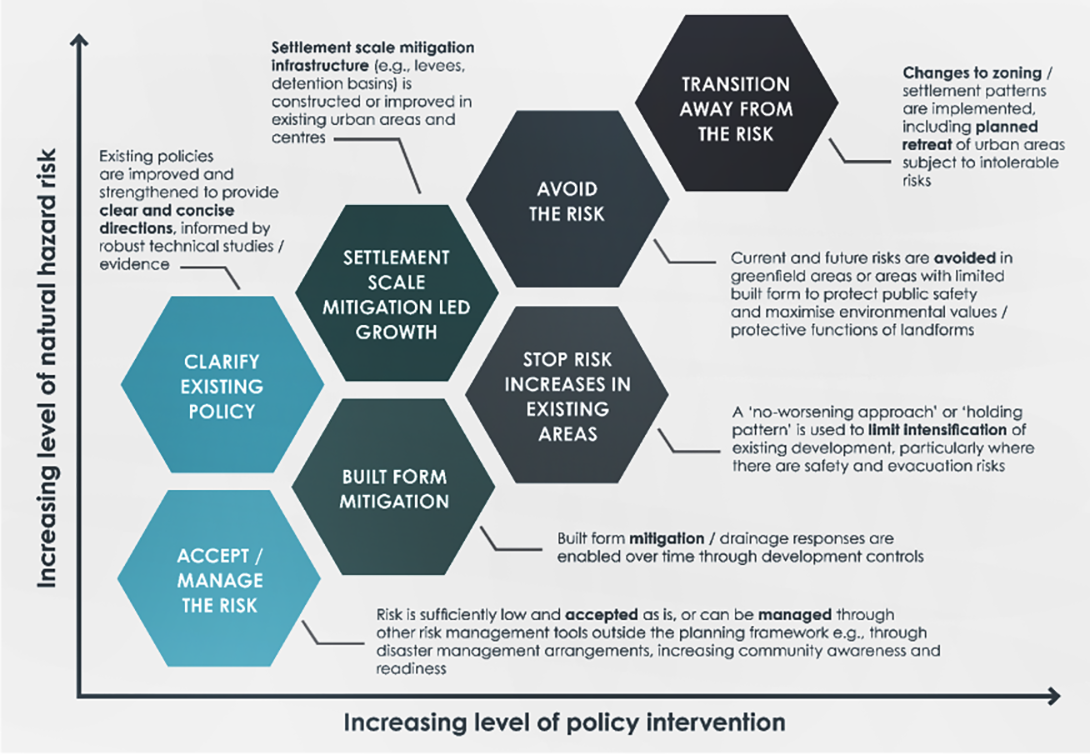Flood Risk Planning Policy Response
What are Planning policy responses?
With all the work that Townsville City Council has done to understand flooding and flood risk in Townsville, we now need to make some decisions about how we use this information to plan for a more flood resilient city.
The Townsville City Plan (sometimes referred to as ‘the planning scheme’) sets out the standards that new development in Townsville is expected to meet. We are now looking at ways that we can improve flood resilience standards in our planning scheme. Some of these new ways to address flood risk are Queensland Government requirements or industry best practice which we have to use, but there is still some flexibility in our approach.
What are the ways we can respond?
Depending on the level of flood risk there are different ways that we can respond to flood risk.
| Lower Risk | Moderate Risk | Higher Risk |
|---|---|---|
| Accept or Manage the Risk | Built Form Mitigation | Stop Risk Increases in Existing Areas |
| Clarify Existing Policy | Settlement Scale Mitigation Led Growth | Avoid the Risk |
| Transition Away from the Risk |
An explanation of these responses:

How have the responses been drafted?
Townsville City Council has engaged external experts in this field to make recommendations to Council of about how the new flood risk mapping can be effectively incorporated into our planning scheme to maintain and enhance flood resilience. Our teams have considered these recommendations to help shape our policy responses, thinking of what will work best for Townsville.
These planning policy responses are set out in the Townsville Inundation Hazards Risk Assessment and Planning Scheme Review – Planning Scheme Response (PDF, 5.8 MB).
What are the proposed planning policy responses?
Generally, the higher the risk category the stricter the controls will be on development, in lower category risk levels more responsibility to manage the risk will be place on individual landowners. The proposed planning policy responses cover a wide range of options from retaining existing provisions to restricting development in higher hazard areas. Some of the more significant change options that are being considered are outlined below. It is important to note that these positions have not been finalised and Council is seeking community input on some of these proposed responses to flood risk.
Built form flood mitigation
In low to medium flood risk areas onsite mitigation may be appropriate to reduce flood risk. Onsite mitigation could include:
- built form mitigation, requiring:
- new buildings to be designed and constructed to withstand flood impacts
- minimum floor heights
- flood resilient building materials
- requiring new lots to have flood resilient access
- filling or excavation prevents offsite flood impacts.
- require new buildings to avoid high flood risk areas.
Limit accommodation activities in higher risk areas
Strict avoidance to prevent new accommodation activities such as dwellings or tourist accommodation in very high and high flood risk areas.
Protection of Vulnerable uses
Requiring developments for Vulnerable uses, such as schools and hospitals, to avoid medium, high and very high-risk areas. Requiring Vulnerable uses on land subject to low flood risk to achieve an appropriate minimum floor levels.
Minimum flood free area for new residential lots
Requiring new residential lots to have a minimum area of flood free land outside of very high, high and medium risk area.
- 250m2 for urban residential lots.
- 600m2 for rural residential lots.
Acceptable uses in higher flood risk areas
Some uses such as parks or other outdoor recreation and environmental use may occur in high to very high flood risk areas. All buildings and structures, park equipment, and recreational assets should be located on part of the land that is outside very high and high flood risk areas. Environmental values of natural areas are to be maintained. Certain components of development such as car parking areas and soft landscaping may also be acceptable in higher flood risk areas
Operational works
Filling or excavation does not result in any increase in flood risk or flood hazard to other properties. The flood storage capacity of a site and flood flow conveyance through a site should be maintained or improved. Filling and excavation in higher flood risk areas only occurs to mitigate flood impacts in lower flood risk areas.
Extensions and reuse of existing buildings in higher flood risk areas
Internal fit outs within existing buildings are permitted even if in the high and very high flood risk areas provided the changes do not increase the risk to people and property.
Stop/limit development intensification in higher flood risk areas
In some of the more extreme flood risk areas it may be appropriate to stop further increases in development and limit further intensification of existing uses, particularly where there are safety and evacuation risks. This would be a no-worsening approach.
Consider the zoning in highest risk areas
In the most extreme flood risk areas, if the risk is too high, Council may have to consider if the current zoning is still appropriate and fit for purpose. Rezoning is a last resort and Council will need to consider all other alternatives before proposing rezoning.
If properties are proposed to be rezoned as part of a future planning scheme amendment, any affected landowners will need to be notified of potential changes and given the opportunity to make a submission prior to any zoning changes being accepted.
Class 10a buildings (sheds, garages, patios, carports etc.) associated with residential uses in flood risk areas
Even small-scale development such as sheds, garages, patios and carports can affect flooding impacts. Council is considering having flood resilience requirements for these structures within the high and very high flood risk areas to ensure the structure does not increase the risk to people, property and the environment both onsite and offsite.
Any changes in policy will only apply to new development or increases to existing development. Any existing buildings, houses or developments will not need to change based on new flood information or policies.
How will community views be considered?
In late 2024, Townsville City Council sought feedback from the community and development industry about some of the proposed planning policy responses. To do this, we created a survey with questions about ways we can improve flood resilience. The survey period ran from 4 November 2024 until 15 December 2024.





